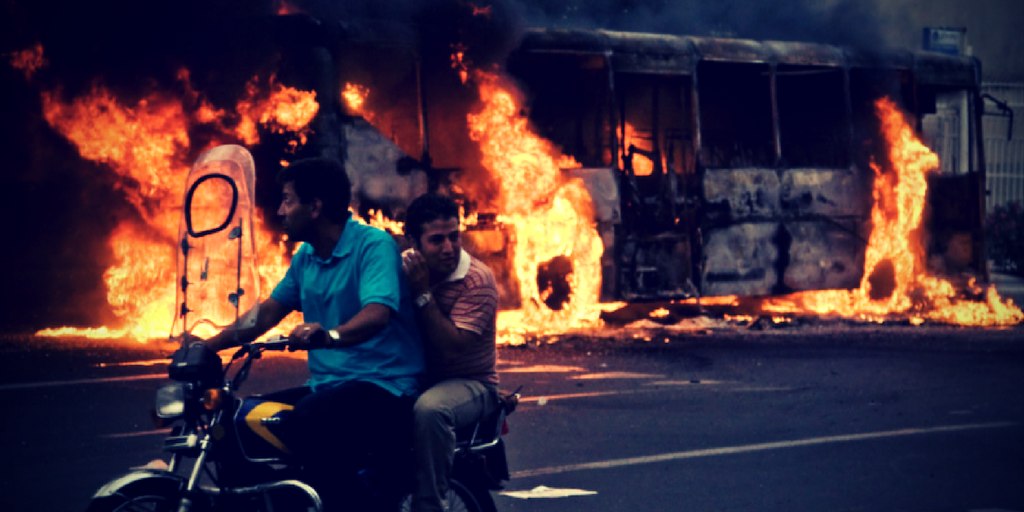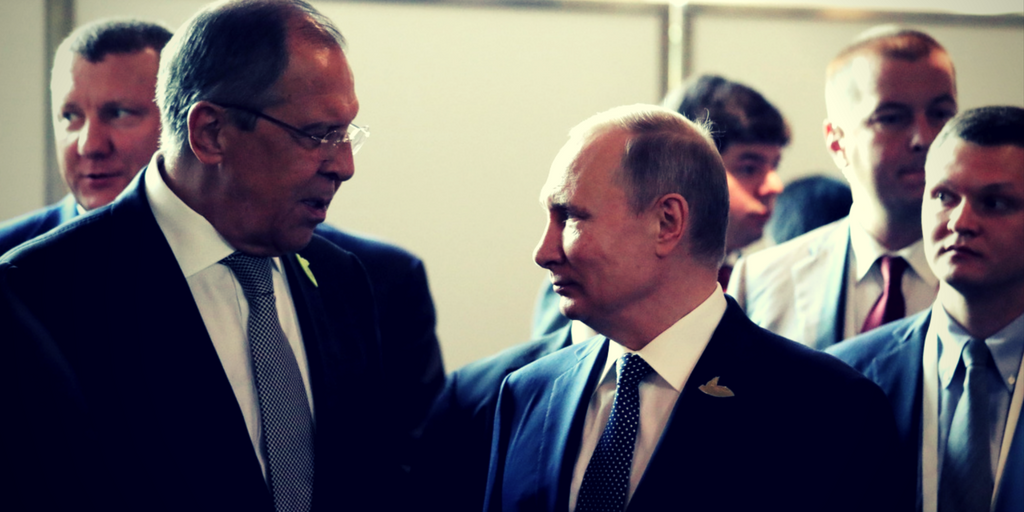Former UN Ambassador John Bolton gave an excellent interview on Sunday concerning the spreading protests in Iran.
Iran
Iranian Protests are Growing, Citizens Attempt to Take Over Revolutionary Guard Bases
There have been plenty of times when outside observers believed that a real revolution was underway in Iran. The Green Movement of 2009 was the last such uprising only to fizzle out after a lack of support by Obama. With Trump openly supporting the protestors over the last few days, these protests feel different. Western media has reported that the widespread protests over economic disparity have essentially morphed into an entire palette of anger thrusted against the theocratic regime in Tehran.
The regime has responded with full force and an attempt to block the internet.
Raman Ghavni has been reporting on the ground using his Twitter. The latest tweet shows protestors doing the unthinkable and attempting to storm Revolutionary Guard bases.
#Update104–#Breaking_News in #Iran.
Security forces attacked protesters in south and North west of the country.People protecting themselves and in some cities people are trying to take over IRGC bases.
In #ShahinDej IRGC has killed 3 and wounded 11.#IranProtests pic.twitter.com/XtRuwE8jye— Raman Ghavami (@Raman_Ghavami) January 1, 2018
As far as the size of the protests, the following infograph shows a growing movement:
Infographic: How the #IranProtests are spreading across the country
#IranProtests pic.twitter.com/MzxWWjXQer
— Farshid Ghavasiyeh (@FGhavasiyeh) December 31, 2017
Ironically the regime, which used sanctions as a way of deferring responsibility for their citizens’ economic plight has no such shield now that there are no real sanctions. Whether or not the current protests sweeping the country will overturn one of the world’s most despotic regimes is not clear.
What is obvious is that these protests are not isolated incidents nor are they small in nature. While the Ayatollahs insist that they are foreign an funded and driven by Western agents, they have grown too large for anyone to believe that explanation.
In the next few days and weeks it will be critical for a leader or group of leaders to emerge in order for the protests to turn into a far wider revolution.
Donald Trump tweeted the following concerning the wave of anti-regime protests sweeping Iran:
Many reports of peaceful protests by Iranian citizens fed up with regime’s corruption & its squandering of the nation’s wealth to fund terrorism abroad. Iranian govt should respect their people’s rights, including right to express themselves. The world is watching! #IranProtests
— Donald J. Trump (@realDonaldTrump) December 30, 2017
What started out as a series of economic protests in select cities in Iran has turned into the largest wave of anti-regime protests in Iran since the failed Green Movement. Despite the show of force by the regime protests keep growing threatening to spiral out of control.
#Update48– #Tehran, anti riot forces and equipments being transferred to places in which most protesters are.#IranProtests pic.twitter.com/BkyIuP5wRZ
— Raman Ghavami (@Raman_Ghavami) December 30, 2017
#Update48– #Tehran, anti riot forces and equipments being transferred to places in which most protesters are.#IranProtests pic.twitter.com/BkyIuP5wRZ
— Raman Ghavami (@Raman_Ghavami) December 30, 2017
Unlike the Green Movement, which many blame Obama for not backing at the same time he backed the Arab Spring, Donald Trump has gone out and warned Iran. Does this mean he will step in. Absolutely not, but what is clear is that his vocal support maybe key in helping to further destablize what is seen as a brutal theocratic regime.
With Iran on the move across the Middle East, the regime has pumped billions of dollars into bolstering its proxies while many of its citizens suffer from economic woes.
For this revolution to succeed, it cannot be seen as a Western inspired uprising, but rather homegrown in nature. So far that seems to be the case. While the IRCG and the security forces are brutal, the populace must hang in there for this to have long term consequences for the Ayatollahs and their supporters. With internal divisions growing in Iran, it is clear that this may take off.
Yet, if the Iranian regime believes this uprising threatens its very existance, war may be the regime’s only way out.
As I currently sit in my house South of Jerusalem, there is a storm rising on Israel’s Northern border. The storm is the Iranian axis made up of the Syrian regime, Hezbollah, and Iranian special forces. This grouping is now a mere 4km from the Israeli Golan, an unthinkable situation just a few months ago.
It has become increasingly clear that the most potent menace out of the three antagonists is the Lebanese Hezbollah. What was once just an Iranian proxy, has become a battle heartened army over the last few years of fighting to save Assad’s regime in Syria. The Hezbollah now boasts over 100 thousand rockets aimed at Israel. Their armed forces are not only situated North of Israel, but now buttress the Hermon, a strategic mountain that overlooks Israel’s Hula valley and Northern coastal areas.
How did this happen? How did Hezbollah become such a threat to Israel? Now, before I write further, I want to make it clear that the Israeli government going back to former Prime Minister Ehud Barak who hastily pulled out of Southern Lebanon, thus ceding control to Hezbollah deserves some of the initial blame for Israel’s current strategic situation.
Yet, it is becoming apparent thanks to Josh Meyer at Politico that the Obama administration had willfully shut down and blocked key parts of Project Cassandra, a secret program started in 2008 under the auspices of the DEA to target Hezbollah’s billion-dollar criminal enterprise and in many cases block it. Hezbollah’s financing has been critical in allowing what was once just a terrorist organization to grow into a political movement and formidable army.
Meyer’s piece, which has become the focus of a cross-section of politicians and pundits since its publication on the 18th of December, essentially blew the lid off the fallout of Obama’s Iranian appeasement policy.
“In its determination to secure a nuclear deal with Iran, the Obama administration derailed an ambitious law enforcement campaign targeting drug trafficking by the Iranian-backed terrorist group Hezbollah, even as it was funneling cocaine into the United States, according to a POLITICO investigation,” Meyer starts his article.
“The Obama administration derailed an ambitious law enforcement campaign targeting drug trafficking by the Iranian-backed terrorist group Hezbollah.”
Meyer’s article is thick with investigative research. Despite push back by former Obama and Clinton officials, it is hard to dismiss his findings. There is no need to reproduce in this article what Meyer wove together over at Politico.
What is important to understand is that Israel’s most determined enemy was allowed to grow and build its army and weaponry with full knowledge and acceptance by former President Obama. This is not a small matter and the decision to allow this was clearly not taken without the understanding that doing so would essentially put Israel into mortal danger as it may very well be now.
The Iranian axis may still have captured Beit Jinn this past week, but its ability to inflict blow after blow against Israel would not be as potent if it were not for Obama’s reckless determination to reach a deal with the Iranian regime on the back of Israel’s safety.
The coming war between Israel and its mortal enemies is a direct consequence of the policy decisions in the Obama administration. Without the chaos of the Arab spring, which Obama championed, nor the overtures to the Iranian regime, by the President himself, Iran would have never been able to reach to the Levant. Iran made the progress it did in large part due to the help of a well-financed Hezbollah.
The coming weeks are critical for Israel as war seems to be a foregone conclusion. It is important that the truth be uncovered concerning the Obama administration’s role in railroading a program that was designed to weaken one of Israel’s and the USA’s most diehard enemies. It is also imortant that writer’s like Josh Meyer are championed instead of attacked as is happening now by public agents close to the Obama and Clinton teams.
In a statement sure to raise tensions between Russia and the USA, Russian Foreign Minister Sergey Lavrov stated on Thursday that US forces must leave all of Syria.
“Speaking to Interfax news agency on Thursday, Lavrov stated that the UN Security Council has not approved the work of the United States and its coalition in Syria, nor has been invited by the Syrian legitimate government.”
Of course, pulling out of Syria is not an option for the US. With major operations against ISIS underway by the Kurdish majority SDF in the North and the US forces at Al-Tanf crossing there to protect Jordan from militants, the idea that the US will just up and leave is a non-starter.
Is Assad Legitimate?
Russia has for a while insisted that any long term presence of foreign troops must be in accordance with the legitimate government of Syria. For Russia this means Assad. The problem with this line of reasoning is that large areas of Syria are clearly not under his control. This is does not refer to pockets of ISIS or Jihadists, but rather indigenous people such as the Kurds of Rojava or Arab Sunnis in the North. These groups along with ethnic Turkmen had been kept down by the minority Allawite regime for decades.
It would seem that any decisions on who gets to stay in Syria should be decided by the most democratic elements in the country. That is, if you consider Syria an actual country at this point. Syria, like many of its Arab counterparts across the Middle East are artificial creations that sprang into being after World War One. given the fact, that Syria has been ruled by dictators for a good part of the last 100 years, it make sense why Russia would view this as trait to determine who is legitimate. Afterall, Russia is currently ruled by an ex KGB chief who snuffs out opposition. This point of commonality between Russia’s Putin and Syria’s Assad would be reason enough for the two to work together, but the truth is Russia doesn’t care about legitimacy just control over Syria in order to press against the West and drain energy from it while Russia pushes against Eastern Europe.
How Does this Affect Israel?
With the US not leaving Syria anytime soon and Russia digging in its heels throughout the country, the stage is set for a serious confrontation between the two super powers’ proxies. Iran-Syria-Hezbollah forces will be used by Russia to push against the US proxies of Israel and the SDF. This will be done under the Russian protective umbrella and threatens to spill out into a far greater war.
In the weeks ahead Israel and the Syrian regime will move beyond tit for tats and go directly against one another while the big powers push from behind.







